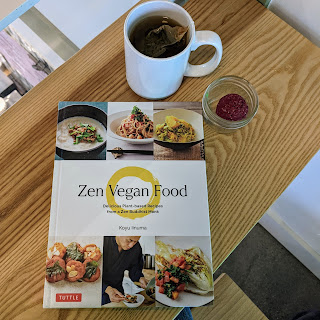Review: Zen Vegan Food by Koyu Iinuma
My quick take: This is an interesting vegan cookbook highlighting Japanese Zen temple food. It seems a bit challenging when you look at the recipes, especially if you are unfamiliar with preparing Japanese dishes, but once you choose the recipes and make a fun trip to your local Japanese supermarket (or order ingredients online if you are in a smaller centre) this is actually easy, satisfying, and makes you feel good for preparing it with no animal products and little waste. It also makes for a very fun dinner party!
***
***
This article was originally published by The Mindful Word on May 8, 2022.
***
One of life’s greatest pleasures is sharing a meal with family and friends. I enjoy exploring new cuisines: unfamiliar tastes can excite the palate, and finding new ways to prepare foods can lead to a fuller understanding of different cultures.
I’ve been on a path to discover a less harmful way of indulging in the pleasures of food, which has led me to explore vegetarian and vegan options. I haven’t eaten meat or poultry for many years, and I’m gradually making an attempt to opt for animal-free eating more often. Ahimsa is the Sanskrit term for “non-harm,” and is related to the five precepts of Buddhism. Gradually, I’m exploring my diet as a way to reduce harm to myself, other living beings and our planet.
Enter Zen Vegan Food: Delicious Plant-based Recipes from a Zen Buddhist Monk, a new cookbook from a Japanese monk, Koyu Iinuma. The book showcases 73 recipes centred on shojin ryōri, which is also known as Buddhist temple cuisine. It’s a straightforward, compact and refreshingly un-fussy book packed full of Zen cuisine facts and gorgeous pictures. Despite the fact that I haven’t cooked vegan Japanese food at home before, the recipes were easy to follow and satisfying to prepare.
I enjoyed exploring my local Japanese market for mushrooms I’d never heard of: beech (shimeji) and “hen of the woods” (maitake). I made Mushroom Miso Paste, a base mixture used in several other recipes. The paste was easy to prepare, and was so rich and deep with flavour that I couldn’t wait to try it out! It acted as the accent flavour to Zen Vegan Mapo Tofu, a much gentler but just as satisfying take on traditional mapo tofu, as well as the oh-so-pretty morsels of Miso Glazed Deep-Fried Tofu, which makes a wonderful appetizer.
I made a dashi stock for the base of several dishes by simmering kombu seaweed. I’d normally discard it, but Iinuma pointed out that this “dashigara kombu” can be repurposed to produce delicious results. I decided to make Quick-Simmered Kombu by steeping the boiled kombu in sugar, soy sauce and sake over low heat. It was surprisingly delicious!
I also made some Doubled-Up Kabocha Squash, in which succulent squash cubes are slathered in a sauce made of squash peel. In Japan, “tomo-ae” indicates a main dish that’s paired with a sauce made of the same plant, and this a hallmark of Zen vegan cooking. Finally, I cooked for the first time with daikon radish, and then used the peels to make Spicy Daikon Radish Peel. This was the hit of the evening—everyone raved about it, even though it was made from a part of the vegetable I’d normally compost.
As the chef, we’re encouraged to take our diners into consideration, with their varied taste preferences, and make adjustments where they’re needed. While cooking meals from the book, there were some subtly flavoured main dishes that I accented with the more spicy daikon radish peel or salty simmered kombu. I also provided the Japanese seven-spice blend shichimi togarashi, as suggested by the author, to amp up the spiciness for my guests.
“Preparing with care,” in regard to this food, meant that I focused mindfully while cooking and engaged in kindness towards myself. It meant sharing a connection with my guests through food. It meant preparing food with minimal waste and without animal products, in order to help care for our planet. I’m grateful to Koyu Iinuma for sharing his care-based cooking philosophies with us.
I’ve been on a path to discover a less harmful way of indulging in the pleasures of food, which has led me to explore vegetarian and vegan options. I haven’t eaten meat or poultry for many years, and I’m gradually making an attempt to opt for animal-free eating more often. Ahimsa is the Sanskrit term for “non-harm,” and is related to the five precepts of Buddhism. Gradually, I’m exploring my diet as a way to reduce harm to myself, other living beings and our planet.
Enter Zen Vegan Food: Delicious Plant-based Recipes from a Zen Buddhist Monk, a new cookbook from a Japanese monk, Koyu Iinuma. The book showcases 73 recipes centred on shojin ryōri, which is also known as Buddhist temple cuisine. It’s a straightforward, compact and refreshingly un-fussy book packed full of Zen cuisine facts and gorgeous pictures. Despite the fact that I haven’t cooked vegan Japanese food at home before, the recipes were easy to follow and satisfying to prepare.
No animal-based proteins or dairy
Soy-based protein is foundational to this cookbook, but I also discovered a plethora of recipes that incorporated mushrooms as a meat substitute or accent. As Iinuma points out, mushrooms have a high amount of guanylic acid, which gives them their distinct umami quality. And I like mushrooms for a more fanciful reason: They remind me of interconnectedness, with their vast mycelial networks!I enjoyed exploring my local Japanese market for mushrooms I’d never heard of: beech (shimeji) and “hen of the woods” (maitake). I made Mushroom Miso Paste, a base mixture used in several other recipes. The paste was easy to prepare, and was so rich and deep with flavour that I couldn’t wait to try it out! It acted as the accent flavour to Zen Vegan Mapo Tofu, a much gentler but just as satisfying take on traditional mapo tofu, as well as the oh-so-pretty morsels of Miso Glazed Deep-Fried Tofu, which makes a wonderful appetizer.
This cuisine uses the whole vegetable
What a wonderful ideal: to appreciate the vegetable so much that we use all of it to the best of our ability. It’s an expression of maximum gratitude for the bounty we’re lucky to have, and Iinuma wove this principle throughout the pages of this book.I made a dashi stock for the base of several dishes by simmering kombu seaweed. I’d normally discard it, but Iinuma pointed out that this “dashigara kombu” can be repurposed to produce delicious results. I decided to make Quick-Simmered Kombu by steeping the boiled kombu in sugar, soy sauce and sake over low heat. It was surprisingly delicious!
I also made some Doubled-Up Kabocha Squash, in which succulent squash cubes are slathered in a sauce made of squash peel. In Japan, “tomo-ae” indicates a main dish that’s paired with a sauce made of the same plant, and this a hallmark of Zen vegan cooking. Finally, I cooked for the first time with daikon radish, and then used the peels to make Spicy Daikon Radish Peel. This was the hit of the evening—everyone raved about it, even though it was made from a part of the vegetable I’d normally compost.
Preparing the cuisine with care
On the sixth page, the author explains the principle of chudo, or the “middle road” of Buddhism, as “never straying too far to one side or another, and accepting all kinds of people.” In the Zen vegan tradition, the balance between sour, bitter, sweet, hot and salty is critical. Tanmi, the subtle flavours the ingredients impart, is paramount. Iinuma notes that “tan” means “not heavy,” and equates this to the middle road of Buddhist philosophy.As the chef, we’re encouraged to take our diners into consideration, with their varied taste preferences, and make adjustments where they’re needed. While cooking meals from the book, there were some subtly flavoured main dishes that I accented with the more spicy daikon radish peel or salty simmered kombu. I also provided the Japanese seven-spice blend shichimi togarashi, as suggested by the author, to amp up the spiciness for my guests.
“Preparing with care,” in regard to this food, meant that I focused mindfully while cooking and engaged in kindness towards myself. It meant sharing a connection with my guests through food. It meant preparing food with minimal waste and without animal products, in order to help care for our planet. I’m grateful to Koyu Iinuma for sharing his care-based cooking philosophies with us.



Comments
Post a Comment